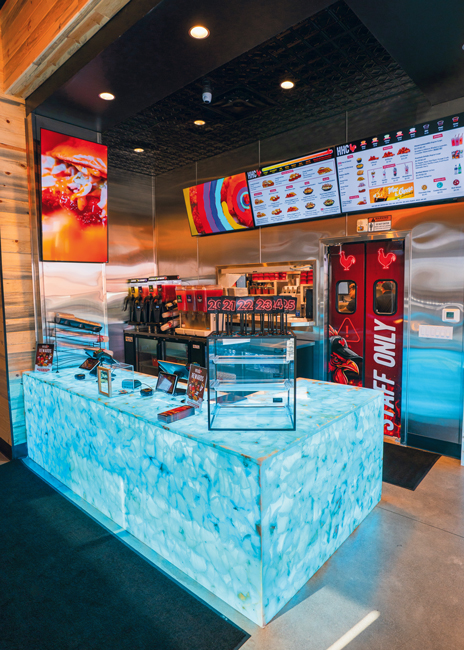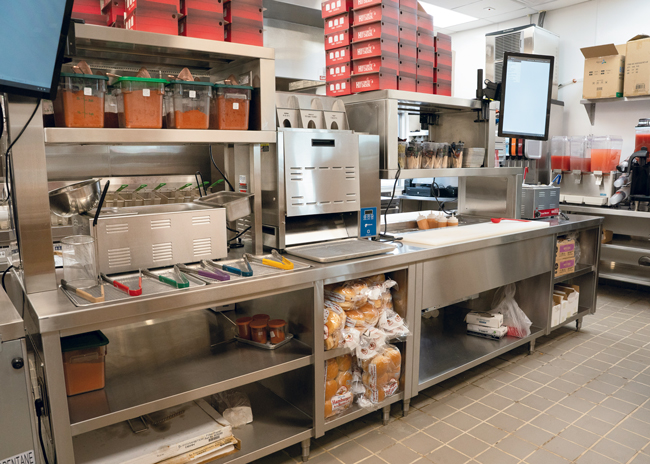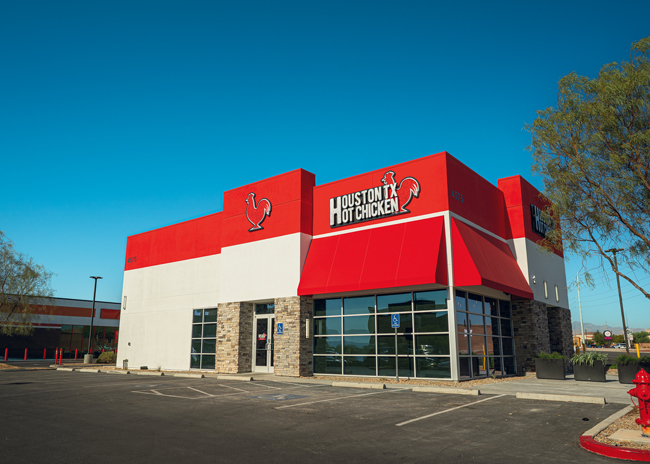Houston TX Hot Chicken has big growth plans, thanks to a lively interior and even livelier food.
Houston TX Hot Chicken (HHC) didn’t start in Houston. Its founder isn’t from Houston. In fact, only two of the chain’s restaurants happen to be in the Houston area.
So what’s with the name?
 According to President Brian Simowitz, the moniker is a play on the chain’s most intense heat level. “One of the spice levels [founder Edmond Barseghian] created was called Houston, We Have a Problem, and that morphed into Houston TX Hot Chicken,” he says. “Houston, We Have a Problem is still one of our signature spices — you have to sign a waiver to order that product. It’s very, very spicy.”
According to President Brian Simowitz, the moniker is a play on the chain’s most intense heat level. “One of the spice levels [founder Edmond Barseghian] created was called Houston, We Have a Problem, and that morphed into Houston TX Hot Chicken,” he says. “Houston, We Have a Problem is still one of our signature spices — you have to sign a waiver to order that product. It’s very, very spicy.”
Indeed, chicken with Houston, We Have a Problem seasoning registers 2 million Scoville heat units (SHU). For context, the typical jalapeño sits at 5,000 SHU.
While that’s popping — and eye-watering — HHC isn’t just a dare in restaurant form. The chain serves chicken at all heat intensities, starting at spice-free. It’s also committed to a quality menu with a few extra options not found in typical chicken joints.
The chicken, for example, is shipped fresh to each store, where staffers brine breasts, strips and nuggets in buttermilk, bread them and fry them fresh. This in-house approach carries over to many of HHC’s other offerings. Each store makes its own chicken tortilla soup and its own macaroni and cheese, for instance. Guests can also choose from a variety of house-made dipping sauces for their meals, including a warm cheese sauce, ranch and the tangy Texas Caesar.
This approach has helped HHC grow to 30 locations in 8 states (primarily in the western U.S.) since its founding in 2021. It also drew the attention of private equity firm Savory Fund, which took a stake in the company in late 2023.
Built for Speed
It isn’t just the food that’s helped HHC grow, of course. The chain’s appearance has also helped build its following. Starting with the basics: HHC has a mix of hard and soft elements. The flooring, for instance, is sealed concrete, and the ceiling is open with all mechanical elements painted black. To soften the space, the walls are clad in wood slats, while the bulbs in the hanging fixtures emit a warm, welcoming light.
 The POS counter is made of a quartz-like material and lit from below with color-changing LEDs.Race cars, seen throughout the space, represent one of Barseghian’s passions and serve as a theme of the design. Take the chain’s signature design element, the female race car driver mural. This piece changes slightly from one location to the next, but all versions feature a close-up painting of a woman’s face with flames coming out of her sunglasses or earrings.
The POS counter is made of a quartz-like material and lit from below with color-changing LEDs.Race cars, seen throughout the space, represent one of Barseghian’s passions and serve as a theme of the design. Take the chain’s signature design element, the female race car driver mural. This piece changes slightly from one location to the next, but all versions feature a close-up painting of a woman’s face with flames coming out of her sunglasses or earrings.
In early stores, this mural was hand-painted on one of the wood slat walls. The chain has since found a more affordable method. “We’ve got a process now where they actually produce the mural on wood slats, and we kind of put it together like a jigsaw puzzle on the wall,” Simowitz says.
Other pieces of wall decor have a tongue-in-cheek style. There’s a painting of a race car driver with a chicken standing on his helmet, a pink neon chicken and a photo of a vintage race car with a chicken standing on its roof.
Perhaps the most eye-catching element of the interior is the POS counter, though. Instead of just a solid surface product, HHC uses a translucent quartz-like material with LEDs below. The result is basically a counter that glows.
Matching the energy of the design is the energy of the restaurant’s “very high-quality sound systems playing very upbeat music,” says Simowitz. “It’s really an atmosphere that appeals to that 16-to-35 demographic. It feels almost a little upscale when you walk in — it looks like a very nice restaurant, which is different for a fast-casual restaurant. So that’s the first wow factor.”
 The main assembly lines at Houston TX Hot Chicken include a seasoning station, a toaster for buns and a sandwich table.
The main assembly lines at Houston TX Hot Chicken include a seasoning station, a toaster for buns and a sandwich table.
Laying It on the (Assembly) Lines
HHC’s interior brings guests in stores, but it’s also got a robust delivery and drive-thru business. Like many operations, HHC now uses a second assembly line to accommodate these different order streams. The chain’s design is particularly flexible, though. While there are two production lines, thanks to an integrated POS/KDS system, these lines can handle any type of order, says Simowitz. “We can easily convert one line to catering orders that are going out, or we can convert it to drive-thru, or we can shut down one line,” he says. “It gives us a lot of flexibility in how we handle and adapt to the business that’s coming in.”
HHC positions the two lines back-to-back in the middle of the kitchen. They mirror each other perfectly. At the start sits an open hot holding unit for chicken breasts and strips. Staffers on both lines use this piece of equipment.
Customers can order that chicken, of course, at various spice levels. To execute this aspect of the menu, next comes the spicing station. Here, staff dip fried chicken breasts and tenders in oil and hold the protein in a countertop hot holding unit. This same unit also holds the Buffalo sauce. While the chain has other sauces for sandwiches and dipping, this is the only sauce that goes directly onto the chicken.
Dipping the chicken in oil allows seasoning to stick. Staffers then put the oiled chicken in a metal bowl, add the guest’s desired seasoning and toss them together. The spices sit in shakers on a shelf just above the oil.
Past the hot holding unit, each line has its own vertical conveyor toaster with dedicated slots for the heel and crown of the bun as well as for Texas toast. This piece plays a key role in producing the chain’s top-selling item, the Original Hot Chicken sandwich, says Simowitz.
After the spicing area comes another mirrored station, this one for sandwich assembly. This area includes a cold table with wells for ingredients like pickles, coleslaw and various sauces/dips, including ranch, barbecue sauce and maple syrup.
The mirrored assembly lines finish with a station on the endcap. Here, there’s another hot holding station. This one is used for the chain’s house-made chicken tortilla soup, mac and cheese, and warm cheese sauce for dipping or putting on a sandwich. A pop-up toaster sits on a shelf set back from the hot holding unit. This piece warms HHC’s Belgian waffle, which the chain orders frozen.
While the middle assembly lines handle most orders, there’s much more to HHC’s kitchen. On one side of the line against a wall sits a cold table for salads. Guests can order the chain’s salads with chopped chicken tenders, held in the holding unit on the main assembly line a few steps away.
This aspect of the design may change in the future, according to Simowitz. “In general, the space between the cold make table on the far left and the line is a little too far because those people need chicken for some products,” he says. “It’s easier if you can just turn around and hand it to them versus walking over.”
Next to the salad table sits the expo station, where staff add final touches, like small containers of sauces and dips.
While the salad table/expo make up one side of the assembly area, the other is home to the heart of the kitchen, the fry line. This area usually consists of 6 fryers with 12 total baskets. Most fryers handle either chicken breasts or tenders, but some are designated for french fries. HHC holds the fries in a dump station on the same line. This dump station serves both of the assembly lines, with the staffers closer to the dump station typically helping out those on the far side. Below the dump station sits a large refrigerated unit that holds uncooked fries and chicken.
According to Simowitz, HHC is actively looking to change this aspect of the design by moving the fry dump to the end of the assembly lines, close to where the soup and macaroni and cheese are currently held. This shift would make it easier for team members on both sides of the line to add french fries to orders.
The frying line is the last major section of the production area, but HHC’s back of the house also includes a small prep area. It’s here that staffers begin the brining process, rolling chicken into a nearby walk-in cooler once complete. This space has an induction burner, a kettle and a braising skillet for executing items like soup and macaroni and cheese. It also includes a mixer for making sauces like Buffalo and cheese sauce in-house.
 Houston TX Hot Chicken prefers freestanding and endcap spaces. A drive-thru lane sits on the other side of this location.
Houston TX Hot Chicken prefers freestanding and endcap spaces. A drive-thru lane sits on the other side of this location.
Franchise Focused
While still tweaking its kitchen design, HHC continues to generate plenty of interest from franchisees, Simowitz says, as evidenced by its growth projections. “I think in 2026, we will probably open somewhere around 20 locations,” he says. “After that, we’d like to be doing 50 to 60 per year.”
HHC plans to open a few company stores each year in markets where it already operates restaurants. This approach will help HHC serve its franchise partners better, according to Simowitz. “Having a few restaurants that you opened 5 or 10 years ago is very different from opening restaurants today,” he says. “I think it’s important for us to understand what our franchisee is going through. What are the pain points? If construction costs are going crazy and there are areas of opportunity for our franchisees to save money [by reducing construction costs], we’re not going to be able to identify those areas if they’re the ones building all the restaurants.”
Franchising, though, remains the focus. Given the chain’s growth targets, it’s no surprise that HHC is focused on multiunit agreements. The smallest deal the company will sign is for three locations, Simowitz says. What’s more, the company wants experienced restaurant operators who will play an active role in the success of their locations. “The restaurant business isn’t a turnkey business where you open it up and let a general manager run it,” he says. “The general manager is critical, but it’s also critical that we have owners that are engaged and want to be in their restaurants.”
In terms of markets, the chain is looking to expand in and around the eight states where it currently operates. While it does well in city centers and suburbs, HHC particularly thrives near colleges and universities. Younger people, Simowitz says, have proven to be big fans of hot chicken. The company is also interested in opening locations in smaller towns where there’s likely limited competition in the hot chicken segment.
This approach, says Simowitz, should help the chain hit its growth targets and become a major player in the growing hot chicken space. If it succeeds, expansion outside its current territory is certainly on the table.
In the end, a chain founded by a man living in California, based in Las Vegas and named after a city in Texas could be opening restaurants across the country.
At a Glance
- Chain headquarters: Las Vegas
- Year founded: 2021
- Founder: Edmond Barseghian
- President: Brian Simowitz
- VP of operations: Matt Rush
- VP of marketing: Mario Drezo
- VP of training: Chris Patterson
- Investor: Savory Fund
- Signature menu items: Original Hot Chicken sandwich, 2 Tenders & Waffle Meal (sleeper menu item: chicken tortilla soup)
- Number of units: 29
- Unit size: Average 2,500 square feet
- FOH size: 1,000-1,500 square feet
- BOH size: 1,000-1,500 square feet
- Seats per unit: 50-60
- Check average: $25.08
- Real estate: Endcap and freestanding
- Equipment package cost: Approximately $200,000



